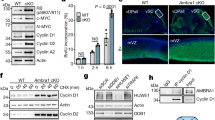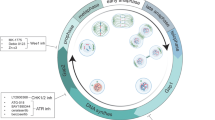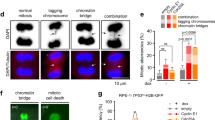Abstract
The DNA replication checkpoint is an inhibitory pathway ensuring that mitosis occurs only after completion of DNA synthesis. Its function may be relevant to the stability of the genome. The essential elements of this checkpoint are ATM/ATR kinases that indirectly lead to the phosphorylation and inhibition of the mitosis-promoting factor (Cdc2/cyclin B1). The function of this checkpoint was analysed in diverse nontransformed and tumour-derived cell lines. All cell lines tested arrested mitosis entry when DNA synthesis was inhibited by hydroxyurea (HU) treatment. But, unlike what has been described in yeast and Xenopus, in normal rat kidney (NRK) cells and NIH 3T3 fibroblasts, the arrest induced by HU treatment was not abrogated by caffeine, an ATM and ATR inhibitor. This indicated the presence of an ATM/ATR-independent response to DNA synthesis inhibition in these nontransformed mammalian cell lines. Interestingly, the behaviour of different tumour cell lines after caffeine treatment varied. While SW480, NP29, NP18 and HeLa cells did not enter mitosis in the presence of caffeine after HU treatment, in CaCo2, DLD1, HCT116 and HT29 caffeine abrogated the checkpoint response. In nontransformed cell lines, lack of cyclin B1 accumulation was observed when DNA synthesis was inhibited. This response was not abrogated by caffeine. In the tumour cell lines, a good correlation between the ability to arrest cell cycle when DNA synthesis was inhibited in the presence of caffeine and the lack of cyclin B1 accumulation was observed. Thus, there is an ATM/ATR-independent checkpoint response that leads to a decrease in cyclin B1 accumulation. However, this response is not functional in some tumour cell lines. Using inhibitors of p38α and β, Mek1, 2 and p53−/− knocked-out fibroblasts, we showed that these proteins were also not involved in this particular checkpoint response. Lack of cyclin B1 accumulation after DNA synthesis inhibition in NRK cells was not due to increased degradation of the protein, but correlated with a decrease in mRNA accumulation.
This is a preview of subscription content, access via your institution
Access options
Subscribe to this journal
Receive 50 print issues and online access
$259.00 per year
only $5.18 per issue
Buy this article
- Purchase on Springer Link
- Instant access to full article PDF
Prices may be subject to local taxes which are calculated during checkout









Similar content being viewed by others
References
Abraham RT . (2001). Genes Dev., 15, 2177–2196.
Barlow C, Hirotsune S, Paylor R, Liyanage M, Eckhaus M, Collins F, Shiloh Y, Crawley JN, Ried T, Tagle D and Wynshaw BA . (1996). Cell, 86, 159–171.
Blasina A, Price BD, Turenne GA and McGowan CH . (1999). Curr. Biol., 9, 1135–1138.
Boddy MN and Russell P . (2001). Curr. Biol., 11, 953–956.
Brown EJ and Baltimore D . (2003). Genes Dev., 17, 615–628.
Bulavin DV, Amundson SA and Fornace J . (2002). Cur. Opin. Gene Dev., 12, 92–97.
Bulavin DV, Higashimoto Y, Popoff IJ, Gaarde WA, Basrur V, Potapova O, Appella E and Fornace AJJ . (2001). Nature, 411, 102–107.
Chan TA, Hermeking H, Lengauer C, Kinzler KW and Vogelstein B . (1999). Nature, 401, 616–620.
Chen F, Zhang Z, Bower J, Lu Y, Leonard SS, Ding M, Castranova V, Piwnica-Worms H and Shi X . (2002). Proc. Natl. Acad. Sci. USA, 99, 1990–1995.
Crawford DF and Piwnica-Worms H . (2001). J. Biol. Chem., 276, 37166–37177.
Dimitrova DS and Gilbert DM . (2000). Nat. Cell Biol., 2, 686–694.
D'Urso G, Grallert B and Nurse P . (1995). J. Cell. Sci., 108, 3109–3118.
Elledge SJ . (1996). Science, 274, 1664–1672.
Fang G, Yu H and Kirschner MW . (1998). Mol. Cell, 2, 163–171.
Feijoo C, Hall-Jackson C, Wu R, Jenkins D, Leitch J, Gilbert DM and Smythe C . (2001). J. Cell. Biol., 154, 913–923.
Hagting A, Jackman M, Simpson K and Pines J . (1999). Curr. Biol., 9, 680–689.
Hagting A, Karlsson C, Clute P, Jackman M and Pines J . (1998). EMBO J., 17, 4127–4138.
Hall-Jackson CA, Cross DA, Morrice N and Smythe C . (1999). Oncogene, 18, 6707–6713.
Hartwell L . (1999). Cell, 71, 543–546.
Hekmat-Nejad M, You Z, Yee MC, Newport JW and Cimprich KA . (2000). Curr. Biol., 10, 1565–1573.
Hirao A, Kong YY, Matsuoka S, Wakeham A, Ruland J, Yoshida H, Liu D, Elledge SJ and Mak TW . (2000). Science, 287, 1824–1827.
Hwang A, Maity A, McKenna WG and Muschel RJ . (1995). J. Biol. Chem., 270, 28419–28424.
Hwang A, McKenna WG and Muschel RJ . (1998). J. Biol. Chem., 273, 31505–31509.
Kastan MB and Lim DS . (2000). Nat. Rev. Mol. Cell. Biol., 1, 179–186.
Krek W and Nigg EA . (1992). New Biol., 4, 323–329.
Kumagai A and Dunphy WG . (1999). Genes Dev., 13, 1067–1072.
Laemmli UK . (1970). Nature, 227, 680–685.
Lopez-Girona A, Furnari B, Mondesert O and Russell P . (1999). Nature, 397, 172–175.
Lukas C, Sorensen CS, Kramer E, Santoni-Rugiu E, Lindeneg C, Peters JM, Bartek J and Lukas J . (1999). Nature, 401, 815–818.
Lupardus PJ, Byun T, Yee MC, Hekmat-Nejad M and Cimprich KA . (2002). Genes Dev., 16, 2327–2332.
Maity A, McKenna WG and Muschel RJ . (1995). EMBO J., 14, 603–609.
Manni I, Mazzaro G, Gurtner A, Mantovani R, Haugwitz U, Krause K, Engeland K, Sacchi A, Soddu S and Piaggio G . (2001). J. Biol. Chem., 276, 5570–5576.
Michael WM and Newport J . (1998). Science, 282, 1886–1889.
Michael WM, Ott R, Fanning E and Newport J . (2000). Science, 289, 2133–2137.
Myung K, Datta A and Kolodner RD . (2001). Cell, 104, 397–408.
Norbury C, Blow J and Nurse P . (1991). EMBO J., 10, 3321–3329.
Nyberg KA, Michelson RJ, Putnam CW and Weinert TA . (2002). Annu. Rev. Genet., 36, 617–656.
Rhind N and Russell P . (1998). Mol. Cell. Biol., 18, 3782–3787.
Santocanale C and Diffley JF . (1998). Nature, 395, 615–618.
Sarkaria JN, Busby EC, Tibbetts RS, Roos P, Taya Y, Karnitz LM and Abraham RT . (1999). Cancer Res., 59, 4375.
Serrano M, Lin AW, McCurrach ME, Beach D and Lowe SW . (1997). Cell, 88, 593–602.
Solomon MJ, Glotzer M, Lee TH, Philippe M and Kirschner MW . (1990). Cell, 63, 1013–1024.
Steinmann KE, Belinsky GS, Lee D and Schlegel R . (1991). Proc. Natl. Acad. Sci. USA, 88, 6843–6847.
Stokes MP, Van Hatten R, Lindsay HD and Michael WM . (2002). J. Cell. Biol., 158, 863–872.
Tam SW, Belinsky GS and Schlegel R . (1995). J. Cell. Biochem., 59, 339–349.
Tanaka S and Diffley JFX . (2002). Genes Dev., 16, 2639–2649.
Taylor WR and Stark GR . (2001). Oncogene, 20, 1803–1815.
Taylor WR, DePrimo SE, Agarwal A, Agarwal ML, Schonthal AH, Katula KS and Stark GR . (1999). Mol. Biol. Cell, 10, 3607–3622.
Wang W, Caldwell MC, Lin S, Furneaux H and Gorospe M . (2002). EMBO J., 19, 2340–2350.
Yang J, Winkler K, Yoshida M and Kornbluth S . (1999). EMBO J., 18, 2174–2183.
Ye XS and Osmani SA . (1997). Prog. Cell Cycle Res., 3, 221–232.
You Z, Kong L and Newport J . (2002). J. Biol. Chem., 277, 27088–27093.
Zachariae W, Schwab M, Nasmyth K and Seufert W . (1998). Science, 282, 1721–1724.
Zeng Y and Piwnica-Worms H . (1999). Mol. Cell. Biol., 19, 7410–7419.
Zhan Q, Antinore MJ, Wang XW, Carrier F, Smith ML, Harris CC and Fornace-AJ J . (1999). Oncogene, 18, 2892–2900.
Zhou BB and Elledge SJ . (2000). Nature, 408, 433–439.
Acknowledgements
We thank Dr Manuel Serrano (Centro Nacional de Biotecnología, Spain) for the gift of p53−/− MEFs. This study was supported by CICYT Grant SAF2001-2901. Roger Florensa is a recipient of a predoctoral fellowship from CIRIT (Catalan government).
Author information
Authors and Affiliations
Corresponding author
Rights and permissions
About this article
Cite this article
Florensa, R., Bachs, O. & Agell, N. ATM/ATR-independent inhibition of cyclin B accumulation in response to hydroxyurea in nontransformed cell lines is altered in tumour cell lines. Oncogene 22, 8283–8292 (2003). https://doi.org/10.1038/sj.onc.1207159
Received:
Revised:
Accepted:
Published:
Issue Date:
DOI: https://doi.org/10.1038/sj.onc.1207159
Keywords
This article is cited by
-
Attenuation potentials of royal jelly against hydroxyurea-induced infertility through inhibiting oxidation and release of pro-inflammatory cytokines in male rats
Environmental Science and Pollution Research (2019)
-
Inter- and intrachromosomal asynchrony of cell division cycle events in root meristem cells of Allium cepa: possible connection with gradient of cyclin B-like proteins
Plant Cell Reports (2010)



